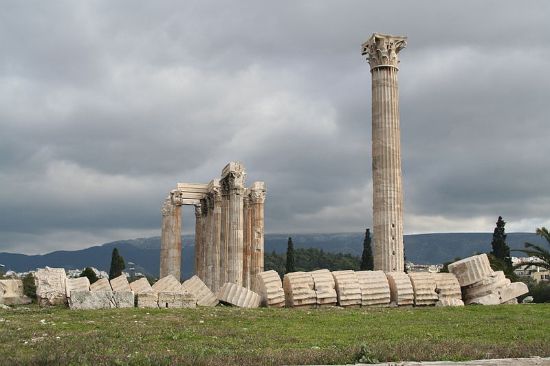
Jacques-Louis David (1748 – 1825)
Oath Of The Horatii
Oil on Canvas, 10' 10" x 13' 11""
1784
Musée du Louvre at Paris
I watched two films yesterday.
One was Spartacus, by Stanley Kubrick, a fictional recounting of the supposed slave rebellion in Rome. I don't know much about the historical accuracy of the film, but this historian says:
Perhaps the most surprising thing is that the Kubrick film isn't complete fiction, but offers some historical truth. The truth is that Spartacus really was a slave and a gladiator in Capua, Italy, and he really did lead a revolt. As the movie shows, it started in the kitchen of the gladiatorial barracks with the men using basic kitchen utensils to fight the guards and break out. And it's even true that Spartacus had a ladylove as he did in the movie. But there are some real differences as well. The movie Spartacus was born a slave and was the son and grandson of slaves, but the real Spartacus was born free. He came from Thrace, roughly equivalent with today's Bulgaria. And far from being a lifelong opponent of Rome, he started out as an allied soldier in the Roman army. He fought for Rome. His fate, ending up as a slave and gladiator, was quite unexpected and quite unjust. The Romans themselves admitted that Spartacus was forced to become a gladiator even though he was innocent. (The historian is Barry Strauss, and here is his link at Cornell University)The other was My Life in Ruins, a silly film with Nia Vardalos (who was in the mildly funny and somewhat successful film My Big Fat Greek Wedding). My Life in Ruins is about a Greek-American academic (Vardalos - highly unlikely as an NYU professor) who goes to Greece as a tour guide (much more likely) to share her erudition with annoying tourists.
Spartacus is by far the superior film. It takes us back to a formal, civilized Rome. The Romans' strategic and methodical fighting plans are deeply contrasted with the thousands of men that Spartacus has amassed, who swarm across the plains towards the Romans during an epic (in the film at least) battle. The Romans, in their beautiful crimson capes, riding their multicolored horses (white for the leaders), with the footmen carrying steely shields, shine against the slaves in their tattered rags of grays and browns. Even in war (especially in war?), the Romans took care with their appearances. Red for blood, red for war, and the crimson red for beauty.
But My Life in Ruins, despite its silliness and its clever title, takes us to ancient Greece. It is hard to imagine that the pretty Greek villages that the tour bus drives by are on the same land as the civilization which built the Parthenon almost 3,000 years ago.
One of the most memorable scenes in the film was when the tour guide takes her motley crew to a ruins site. We see one pillar standing. It is part of the Temple of Zeus at Olympus. As the camera pulls out, we see the rest of the ruins, with scrambling tourists stepping all over the sacred stones.
The effect of the lone pillar, filmed separately from the human rabble, was strong. It was as though these ancient peoples had left behind a god buried deep in the pillar, who was watching over them (their remnants) as well as gently warning these swarming modern humans who they are.
Later on, the tour guide takes her group to the Acropolis at night. Approaching it, we realize why. It is lit up, on the low hill. A regal, gentle presence. I don't think this lighting is out of place. The Greeks would have found a way to light their beautiful monument, with candles and torches, so that it glows for miles around, to admire and to be in awe of.

The Temple of Zeus After Restoration Works
The Temple of Zeus was burnt by order of [the Byzantine Emperor] Theodosius II in AD 426. Badly damaged by the fire, it was finally thrown down by the earthquakes of AD 551 and 552. Excavations at the temple began by the French in 1829, and were completed by the German School. Parts of the sculptural decoration have been restored and are now on display in the Olympia Archaeological Museum, while the metopes removed by the French expedition of 1829 are in the Louvre. Conservation and cleaning of the monument are currently in progress. [Source]And more information below:
Since the 1870s, the excavation and preservation of Ancient Olympia has been the responsibility of the German Archaeological Institute at Athens. The first major excavation of Olympia began in 1875, funded by the German government. [Archaeologists] excavated the central part of the sanctuary including the Temple of Zeus, Temple of Hera, Metroon, Bouleuterion, Philipeion, Echo Stoa, Treasuries and Palaestra. Important finds included sculptures from the Temple of Zeus, the Nike of Paeonius, the Hermes of Praxiteles and many bronzes. In total 14,000 objects were recorded. The finds were displayed in a museum on the site.
Excavation was continued in a more limited way...between 1908 and 1929 but a new systematic excavation was begun in 1936 on the occasion of the 1936 Summer Olympics in Berlin under... [The] excavation focus was on the area to the south of the stadium, the South stoa, bath complex and gymnasion.
Between 1952 and 1966, [archaeologists] excavated Pheidias' workshop, the Leonidaion and the north wall of the stadium. They also excavated the southeast section of the sanctuary and out of approximately 140 debris pits found many bronze and ceramic objects along with terracotta roof tiles.
[E]xcavations between 1972 and 1984 reveal[ed] important dating evidence for the stadium, graves, and the location of the Prytaneion. From 1984 to 1996...the focus shifted to the earlier history of the sanctuary with excavation of the Prytaneion and Pelopion.[Source: 1000 years of the Olympic Games: Treasures of Ancient Greece - pdf file]
